2022年中考英语 考点专项突破课件: 第二章 第十一节 句子种类(共45张PPT)
文档属性
| 名称 | 2022年中考英语 考点专项突破课件: 第二章 第十一节 句子种类(共45张PPT) | 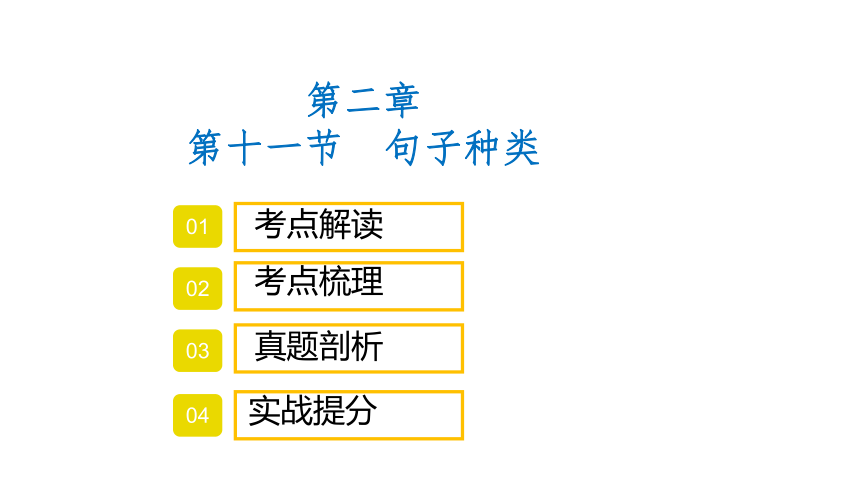 | |
| 格式 | pptx | ||
| 文件大小 | 333.1KB | ||
| 资源类型 | 教案 | ||
| 版本资源 | 牛津译林版 | ||
| 科目 | 英语 | ||
| 更新时间 | 2022-05-11 22:33:22 | ||
图片预览

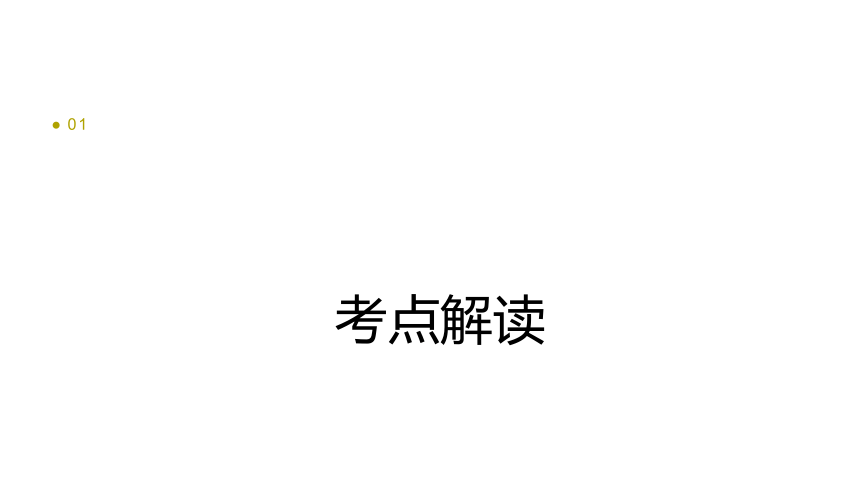
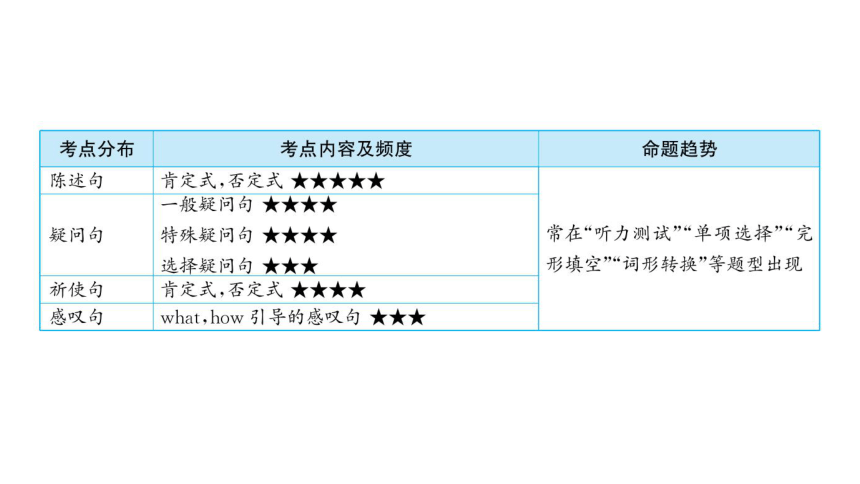
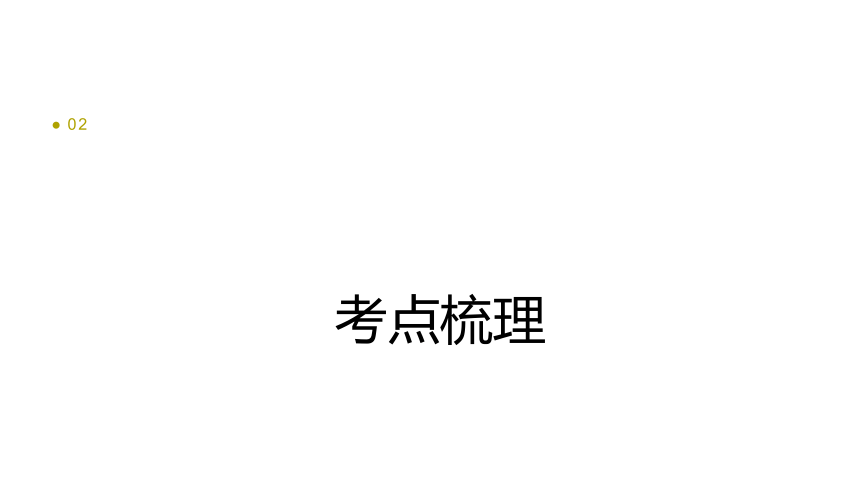
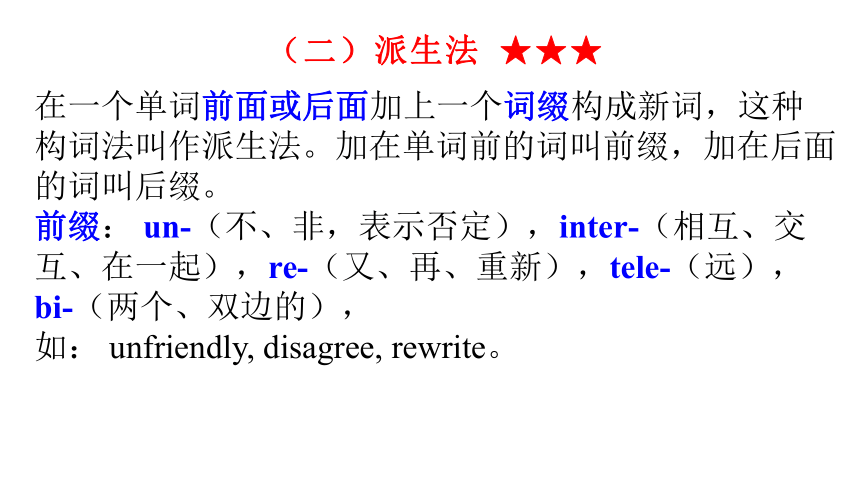
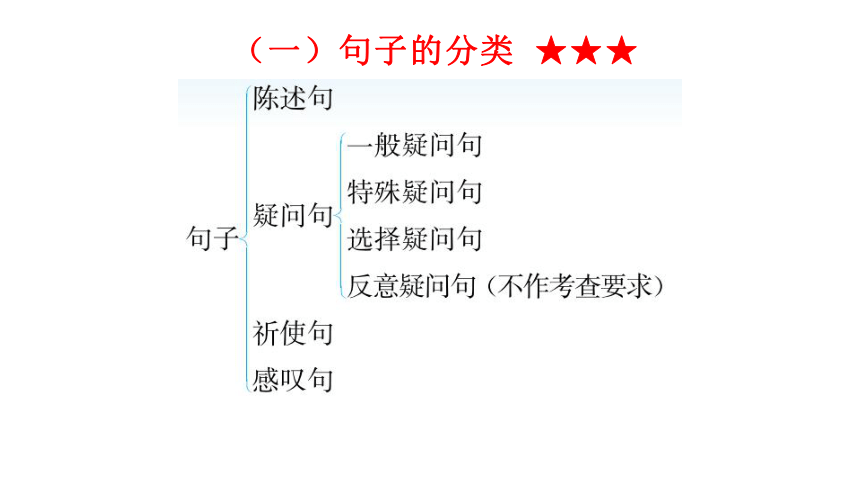
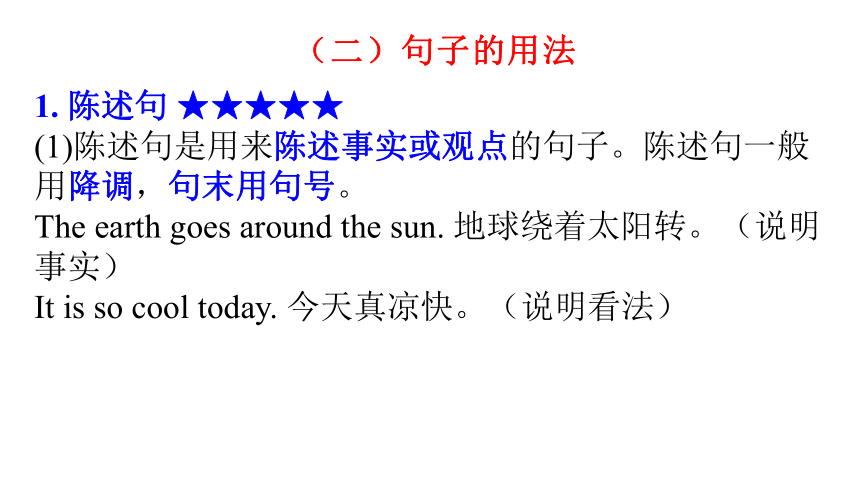
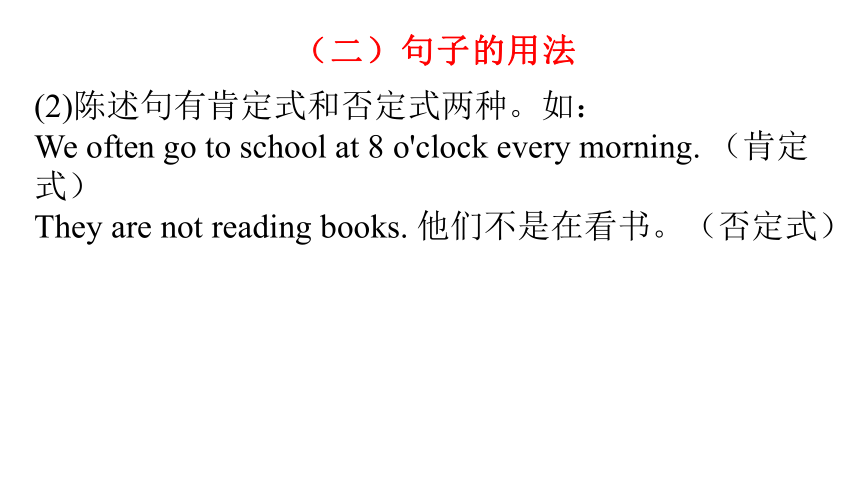
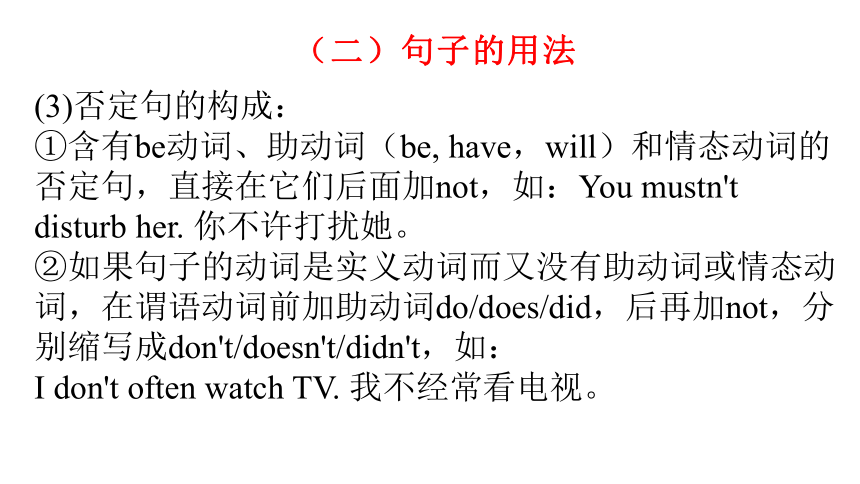

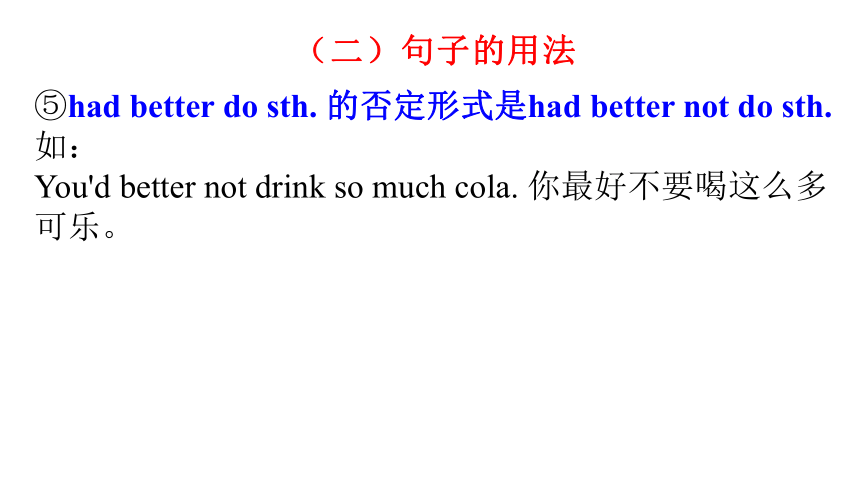

文档简介
(共45张PPT)
01
考点解读
02
03
04
考点梳理
真题剖析
实战提分
第二章
第十一节 句子种类
01
考点解读
02
考点梳理
(二)派生法 ★★★
在一个单词前面或后面加上一个词缀构成新词,这种构词法叫作派生法。加在单词前的词叫前缀,加在后面的词叫后缀。
前缀: un-(不、非,表示否定),inter-(相互、交互、在一起),re-(又、再、重新),tele-(远),bi-(两个、双边的),
如: unfriendly, disagree, rewrite。
(一)句子的分类 ★★★
(二)句子的用法
1. 陈述句 ★★★★★
(1)陈述句是用来陈述事实或观点的句子。陈述句一般用降调,句末用句号。
The earth goes around the sun. 地球绕着太阳转。(说明事实)
It is so cool today. 今天真凉快。(说明看法)
(二)句子的用法
(2)陈述句有肯定式和否定式两种。如:
We often go to school at 8 o'clock every morning. (肯定式)
They are not reading books. 他们不是在看书。(否定式)
(二)句子的用法
(3)否定句的构成:
①含有be动词、助动词(be, have,will)和情态动词的否定句,直接在它们后面加not,如:You mustn't disturb her. 你不许打扰她。
②如果句子的动词是实义动词而又没有助动词或情态动词,在谓语动词前加助动词do/does/did,后再加not,分别缩写成don't/doesn't/didn't,如:
I don't often watch TV. 我不经常看电视。
(二)句子的用法
③有些词本身表示否定意义,如:nobody, hardly, never, none, nothing, few, little, neither 等。如:There are no books on the desk?书桌上没有书。
I can hardly believe it?我简直不能相信。
④在“I think/believe/guess+that从句”的句型中,若是否定从句动词的含义,须采用否定主语动词think/believe/guess的形式,这叫否定前移。如:
I don't think it's true. 我认为那不是真的。
(二)句子的用法
⑤had better do sth. 的否定形式是had better not do sth. 如:
You'd better not drink so much cola. 你最好不要喝这么多可乐。
(二)句子的用法
2. 疑问句
(1)一般疑问句 ★★★★★
一般疑问句是用yes或no来回答的疑问句。一般疑问句的构成是把句中的be动词、情态动词放在句首;如果句中没有be动词或情态动词,则要加助动词do/does/did在句首。如:
Are you Chinese 你是中国人吗?
Can I borrow your pen 我能借你的钢笔吗?
Does Amy like singing 艾米喜欢唱歌吗?
Have they finished their work 他们完成工作了吗?
(二)句子的用法
(2)选择疑问句 ★★★★
选择疑问句是指提出两个或两个以上可能的答案供对方选择的句式。前一部分是一般疑问句或特殊疑问句,后面加上or,提供给对方另一个条件,让对方根据实际情况进行选择回答。如:
—Do you go to school by bus or by bike 你上学是乘公共汽车还是骑自行车?
—(I go to school) By bike. 骑自行车。
(二)句子的用法
(3)特殊疑问句 ★★★★★
以疑问词开头,对句中某一成分提问的句子叫特殊疑问句。常用的疑问词有:what(什么),who(谁),whose(谁的),which(哪个),when(何时),where(哪里),how(怎样), why(为何),how many(有多少),how much(多少)how far(多远),how old(多大)等。 特殊疑问句的构成:
(二)句子的用法
①“特殊疑问词+一般疑问句”的形式。如:
How old are you 你多大了
What's this in English 这个用英语怎么讲
②“特殊疑问词(主语)+陈述句”的形式。如:
Who's not here today 今天谁没来 (提问主语)
Which pen is red 哪支钢笔是红色的 (提问主语的定语)
(二)句子的用法
3. 祈使句 ★★★★★
一般用以发出命令、提出要求或建议时,常用祈使句。祈使句的主语通常不明确表示出来。为了显得更为客气和礼貌,常在祈使句中加上please。当please用在句末时,必须用逗号与其他部分隔开。
祈使句的形式:
(二)句子的用法
①肯定式:一般以动词原形开头。如:
Sit down, please! 请坐下!
Be careful!小心!
Let's go to the zoo! 咱们去动物园吧!
②否定式:一般在动词原形前加do not/don't。如:
Don't talk in the reading room. 不要在阅览室里说话。
(二)句子的用法
③特殊的否定式句型:
Let Alice not come here. 让艾丽丝别来这。
No photos! 禁止拍照!
No smoking! 禁止吸烟!
Never be late for class! 上学不要迟到!
(二)句子的用法
4. 感叹句 ★★★★★
感叹句是用来表达说话者说话时的高兴、惊异、喜悦、愤怒、伤心等思想感情的句子。感叹句通常由What或How来引导,与所修饰的词置于句首,其他部分用陈述句语序。
(二)句子的用法
(1)What引导的感叹句。what用作定语,修饰名词(被强调部分),单数可数名词前要加不定冠词a/an,复数可数名词或不可数名词前不用冠词。如:
①What a lovely boy he is! 他是一个多可爱的男孩呀!
②What lovely boys they are!他们是那么可爱的男孩呀!
③What cute pandas they are!熊猫真可爱呀!
④What hot weather it is!天气真热呀!
(二)句子的用法
(2)How引导的感叹句。how用作状语,修饰形容词或副词(被强调部分)。如果修饰形容词,则句中的谓语动词用系动词;如果修饰副词,则句中的谓语动词用行为动词,如:
①How pretty the girl is! 多漂亮的女孩子啊!
②How fast the lion runs! 这狮子跑得真快呀!
③How nice a house it is! 多么漂亮的房子呀!
④How hard they are working now! 他们现在干得多么努力呀!
03
真题剖析
真题链接
【例1】(2021年柳州)— is the schoolbag?
—60 yuan.
A. How often B. How old
C. How much
【解析】A表示多久一次,B表示多大年纪,C表示多少钱。根据题干中回答可知此处询问这个书包的价格,则C选项符合题意。故选C。
真题链接
【例2】(2021年河池)There a concert in our school hall next week.
A. is B. was
C. will be D. will have
【解析】根据关键词there 和next week,可知此题为there be 结构的一般将来时态,排除AB,因此be动词使用will be。there be句型的一般将来时结构there will be,且there be句型不能与have一起连用。故选C。
真题链接
【例3】(2021年南通)Life is like a one-way race,
treasure every moment as time cannot be won again.
A. so B. and
C. or D. but
真题链接
【解析】so表示“因此、所以”之意,常用来连接两个简单句,这两个简单句有意思上的因果关系。and意为“和,又”,表示并列关系,常用来连接表示对等成分的单词、短语或者句子,表示意思的顺延或增补。or意为“或者”,表示选择关系。另外,在否定句中否定并列成分时,用or,而不用and。but意为“但是”,表示转折关系,所连接的成分意思相反或相对。前句Life is like a one?way race人生就像一场单程赛跑。后句treasure every moment as time cannot be won again.珍惜每一刻,因为时间不可能倒流。联系前后两句,这里表示因果关系,前是因,后是果。故选A。
真题链接
【例4】(2021年玉林)—My mother is planning to have a second child next year.
— _______good idea it is!
A. What B. How
C. What a D. What an
【解析】感叹句的构成为:1?What+a/an+(形容词)+单数可数名词+主语+谓语!2?What+(形容词)+可数名词复数或不可数名词+主语+谓语!3?How+形容词(副词)+主语+谓语!idea是可数名词单数,good以辅音音素开头。故选C。
真题链接
【例5】(2019年玉林)—Wow! clean air we have today!
—Yes. Look! A lot of adults are doing Kung fu over there.
A. How B. What a
C. How a D. What
【解析】本题考查感叹句。句意:—哇!我们现在的空气多清新!—是的。看!好多人在那边练功夫。此题的祈使句结构为“What +形容词+不可数名词+主语+谓语”。clean air作谓语动词have的宾语,air是不可数名词。
易错剖析
【例1】 well she sings! 她唱得多好呀!
A. How B. What
【解析】本题考查感叹句。答案为A,容易误选B。该句型结构为:How +形容词/副词+主语+谓语,此处well(很好地)是副词,修饰sings,而不是用形容词。
易错剖析
【例2】 bad weather it is! 多么糟糕的天气呀!
A. How B. What
C. How a D. What a
【解析】本题考查感叹句。答案为B,容易误选A。weather为不可数名词,该句型结构为:What +形容词+不可数名词+主语+谓语。此句容易与“How bad the weather is!(多么糟糕的天气呀!)”混淆。
易错剖析
【例3】 time flies! 时间过得真快呀!
A. How B. What
C. How a D. What a
【解析】本题考查感叹句。答案为A,容易误选B。该句是个比较特殊的感叹句,完整的句子应为“how (fast) time flies!”,此处省略了句中的副词fast,其句型结构为“How+副词+主语+谓语!”。
易错剖析
【例4】 exciting sport it is to go bike riding!
A. How an B. What an
C. What D. How
【解析】本题考查感叹句。答案为B,容易误选C或D。sport为可数名词单数,形容词exciting修饰名词sport,且exciting是以元音音素开头的单词,因而用an exciting sport,故用What来引导感叹句,其句型结构为“What+a/an +形容词+可数名词单数+主语+谓语”。
易错剖析
【例5】Daniel, play with the mobile phone while you're walking in the street.
A. don't B. doesn't
C. won't D. can't
【解析】本题考查祈使句的否定形式,答案为A,容易误选B。题干中Daniel后面有逗号,说明逗号后面的那句话是对Daniel说的,因此应为祈使句,祈使句的否定形式为:Don't+动词原形。
04
实战提分
基础过关
单项选择。从下列每小题所给的四个选项中,选出可以填入空白处的最佳选项。
1. —All of my classmates have passed the PE test?
— exciting the news is!
A. How B. What
C. What an D. How an
2. — do you visit your grandparents, Timmy
—Once a week?
A. How many B. How long
C. How much D. How often
基础过关
3. more books, and you will improve your reading skills.
A. Reading B. Read
C. Reads D. To read
4. beautiful city it is!
A. How a B. What a
C. How D. What
基础过关
5. John made an unusual robot on his own. creative he is!
A. What B. What a
C. How D. How a
6. —Let's for a walk.
—Good idea?
A. goes B. went
C. gone D. go
基础过关
7. —Do you like moon cakes or sandwiches for a picnic?
— . They are traditional Chinese food.
A. Yes, I do B. No, I don't
C. Moon cakes D. Sandwiches
8. — fast China is developing!
—Yes, we are so lucky to live in such a great country.
A. What B. What a
C. How D. How a
基础过关
9. is important for all of us English loudly in the morning?
A. It; to read B. That; to read
C. It; reading D. That; reading
10. — was your school trip
—It was excellent. We went to the Yellow River.
A. Who B. How
C. What D. Where
拓展提升
1. Nelson exercises because he has too much work every day.
A. usually B. always
C. often D. seldom
2. —Daddy, will you buy me a bendable phone(折叠手机)
—Oh, perhaps in a few months.
A. how long B. how far
C. how soon D. how often
拓展提升
3. —Would you like to watch a movie with me after the exam
— .
A. It doesn't matter B. You're welcome
C. Yes, I'd love to D. Enjoy yourself
4. Look at the blue sky. fine weather it is!
A. How B. How a
C. What D. What a
拓展提升
5. —The drama series The Thunder (破冰行动) hits screens these days.
—Oh. What a pity! I any of them yet,
A. doesn't watch B. didn't watch
C. won't watch D. haven't watched
6. —Do you believe that humans could live on Mars
—I don't think .
A. if it comes true B. that it will come true
C. why it will come true D. how does it come true
拓展提升
7. — can you write in English?
—About forty words per minute.
A. How far B. How often
C. How fast D. How long
8. Dirty air and water are harmful. They kill plants, and even people.
A. can B. can't
C. should D. shouldn't
拓展提升
9. —You looked unhappy just now.
—I missed the school bus and arrived late for class.
A. What did you eat for lunch
B. How was your picnic
C. What happened to you
D. How did you go there
10. — do you help your mother do housework
—Every day. I think it's our duty to do it.
A. How often B. How far
C. How soon D. How much
本 课 结 束
01
考点解读
02
03
04
考点梳理
真题剖析
实战提分
第二章
第十一节 句子种类
01
考点解读
02
考点梳理
(二)派生法 ★★★
在一个单词前面或后面加上一个词缀构成新词,这种构词法叫作派生法。加在单词前的词叫前缀,加在后面的词叫后缀。
前缀: un-(不、非,表示否定),inter-(相互、交互、在一起),re-(又、再、重新),tele-(远),bi-(两个、双边的),
如: unfriendly, disagree, rewrite。
(一)句子的分类 ★★★
(二)句子的用法
1. 陈述句 ★★★★★
(1)陈述句是用来陈述事实或观点的句子。陈述句一般用降调,句末用句号。
The earth goes around the sun. 地球绕着太阳转。(说明事实)
It is so cool today. 今天真凉快。(说明看法)
(二)句子的用法
(2)陈述句有肯定式和否定式两种。如:
We often go to school at 8 o'clock every morning. (肯定式)
They are not reading books. 他们不是在看书。(否定式)
(二)句子的用法
(3)否定句的构成:
①含有be动词、助动词(be, have,will)和情态动词的否定句,直接在它们后面加not,如:You mustn't disturb her. 你不许打扰她。
②如果句子的动词是实义动词而又没有助动词或情态动词,在谓语动词前加助动词do/does/did,后再加not,分别缩写成don't/doesn't/didn't,如:
I don't often watch TV. 我不经常看电视。
(二)句子的用法
③有些词本身表示否定意义,如:nobody, hardly, never, none, nothing, few, little, neither 等。如:There are no books on the desk?书桌上没有书。
I can hardly believe it?我简直不能相信。
④在“I think/believe/guess+that从句”的句型中,若是否定从句动词的含义,须采用否定主语动词think/believe/guess的形式,这叫否定前移。如:
I don't think it's true. 我认为那不是真的。
(二)句子的用法
⑤had better do sth. 的否定形式是had better not do sth. 如:
You'd better not drink so much cola. 你最好不要喝这么多可乐。
(二)句子的用法
2. 疑问句
(1)一般疑问句 ★★★★★
一般疑问句是用yes或no来回答的疑问句。一般疑问句的构成是把句中的be动词、情态动词放在句首;如果句中没有be动词或情态动词,则要加助动词do/does/did在句首。如:
Are you Chinese 你是中国人吗?
Can I borrow your pen 我能借你的钢笔吗?
Does Amy like singing 艾米喜欢唱歌吗?
Have they finished their work 他们完成工作了吗?
(二)句子的用法
(2)选择疑问句 ★★★★
选择疑问句是指提出两个或两个以上可能的答案供对方选择的句式。前一部分是一般疑问句或特殊疑问句,后面加上or,提供给对方另一个条件,让对方根据实际情况进行选择回答。如:
—Do you go to school by bus or by bike 你上学是乘公共汽车还是骑自行车?
—(I go to school) By bike. 骑自行车。
(二)句子的用法
(3)特殊疑问句 ★★★★★
以疑问词开头,对句中某一成分提问的句子叫特殊疑问句。常用的疑问词有:what(什么),who(谁),whose(谁的),which(哪个),when(何时),where(哪里),how(怎样), why(为何),how many(有多少),how much(多少)how far(多远),how old(多大)等。 特殊疑问句的构成:
(二)句子的用法
①“特殊疑问词+一般疑问句”的形式。如:
How old are you 你多大了
What's this in English 这个用英语怎么讲
②“特殊疑问词(主语)+陈述句”的形式。如:
Who's not here today 今天谁没来 (提问主语)
Which pen is red 哪支钢笔是红色的 (提问主语的定语)
(二)句子的用法
3. 祈使句 ★★★★★
一般用以发出命令、提出要求或建议时,常用祈使句。祈使句的主语通常不明确表示出来。为了显得更为客气和礼貌,常在祈使句中加上please。当please用在句末时,必须用逗号与其他部分隔开。
祈使句的形式:
(二)句子的用法
①肯定式:一般以动词原形开头。如:
Sit down, please! 请坐下!
Be careful!小心!
Let's go to the zoo! 咱们去动物园吧!
②否定式:一般在动词原形前加do not/don't。如:
Don't talk in the reading room. 不要在阅览室里说话。
(二)句子的用法
③特殊的否定式句型:
Let Alice not come here. 让艾丽丝别来这。
No photos! 禁止拍照!
No smoking! 禁止吸烟!
Never be late for class! 上学不要迟到!
(二)句子的用法
4. 感叹句 ★★★★★
感叹句是用来表达说话者说话时的高兴、惊异、喜悦、愤怒、伤心等思想感情的句子。感叹句通常由What或How来引导,与所修饰的词置于句首,其他部分用陈述句语序。
(二)句子的用法
(1)What引导的感叹句。what用作定语,修饰名词(被强调部分),单数可数名词前要加不定冠词a/an,复数可数名词或不可数名词前不用冠词。如:
①What a lovely boy he is! 他是一个多可爱的男孩呀!
②What lovely boys they are!他们是那么可爱的男孩呀!
③What cute pandas they are!熊猫真可爱呀!
④What hot weather it is!天气真热呀!
(二)句子的用法
(2)How引导的感叹句。how用作状语,修饰形容词或副词(被强调部分)。如果修饰形容词,则句中的谓语动词用系动词;如果修饰副词,则句中的谓语动词用行为动词,如:
①How pretty the girl is! 多漂亮的女孩子啊!
②How fast the lion runs! 这狮子跑得真快呀!
③How nice a house it is! 多么漂亮的房子呀!
④How hard they are working now! 他们现在干得多么努力呀!
03
真题剖析
真题链接
【例1】(2021年柳州)— is the schoolbag?
—60 yuan.
A. How often B. How old
C. How much
【解析】A表示多久一次,B表示多大年纪,C表示多少钱。根据题干中回答可知此处询问这个书包的价格,则C选项符合题意。故选C。
真题链接
【例2】(2021年河池)There a concert in our school hall next week.
A. is B. was
C. will be D. will have
【解析】根据关键词there 和next week,可知此题为there be 结构的一般将来时态,排除AB,因此be动词使用will be。there be句型的一般将来时结构there will be,且there be句型不能与have一起连用。故选C。
真题链接
【例3】(2021年南通)Life is like a one-way race,
treasure every moment as time cannot be won again.
A. so B. and
C. or D. but
真题链接
【解析】so表示“因此、所以”之意,常用来连接两个简单句,这两个简单句有意思上的因果关系。and意为“和,又”,表示并列关系,常用来连接表示对等成分的单词、短语或者句子,表示意思的顺延或增补。or意为“或者”,表示选择关系。另外,在否定句中否定并列成分时,用or,而不用and。but意为“但是”,表示转折关系,所连接的成分意思相反或相对。前句Life is like a one?way race人生就像一场单程赛跑。后句treasure every moment as time cannot be won again.珍惜每一刻,因为时间不可能倒流。联系前后两句,这里表示因果关系,前是因,后是果。故选A。
真题链接
【例4】(2021年玉林)—My mother is planning to have a second child next year.
— _______good idea it is!
A. What B. How
C. What a D. What an
【解析】感叹句的构成为:1?What+a/an+(形容词)+单数可数名词+主语+谓语!2?What+(形容词)+可数名词复数或不可数名词+主语+谓语!3?How+形容词(副词)+主语+谓语!idea是可数名词单数,good以辅音音素开头。故选C。
真题链接
【例5】(2019年玉林)—Wow! clean air we have today!
—Yes. Look! A lot of adults are doing Kung fu over there.
A. How B. What a
C. How a D. What
【解析】本题考查感叹句。句意:—哇!我们现在的空气多清新!—是的。看!好多人在那边练功夫。此题的祈使句结构为“What +形容词+不可数名词+主语+谓语”。clean air作谓语动词have的宾语,air是不可数名词。
易错剖析
【例1】 well she sings! 她唱得多好呀!
A. How B. What
【解析】本题考查感叹句。答案为A,容易误选B。该句型结构为:How +形容词/副词+主语+谓语,此处well(很好地)是副词,修饰sings,而不是用形容词。
易错剖析
【例2】 bad weather it is! 多么糟糕的天气呀!
A. How B. What
C. How a D. What a
【解析】本题考查感叹句。答案为B,容易误选A。weather为不可数名词,该句型结构为:What +形容词+不可数名词+主语+谓语。此句容易与“How bad the weather is!(多么糟糕的天气呀!)”混淆。
易错剖析
【例3】 time flies! 时间过得真快呀!
A. How B. What
C. How a D. What a
【解析】本题考查感叹句。答案为A,容易误选B。该句是个比较特殊的感叹句,完整的句子应为“how (fast) time flies!”,此处省略了句中的副词fast,其句型结构为“How+副词+主语+谓语!”。
易错剖析
【例4】 exciting sport it is to go bike riding!
A. How an B. What an
C. What D. How
【解析】本题考查感叹句。答案为B,容易误选C或D。sport为可数名词单数,形容词exciting修饰名词sport,且exciting是以元音音素开头的单词,因而用an exciting sport,故用What来引导感叹句,其句型结构为“What+a/an +形容词+可数名词单数+主语+谓语”。
易错剖析
【例5】Daniel, play with the mobile phone while you're walking in the street.
A. don't B. doesn't
C. won't D. can't
【解析】本题考查祈使句的否定形式,答案为A,容易误选B。题干中Daniel后面有逗号,说明逗号后面的那句话是对Daniel说的,因此应为祈使句,祈使句的否定形式为:Don't+动词原形。
04
实战提分
基础过关
单项选择。从下列每小题所给的四个选项中,选出可以填入空白处的最佳选项。
1. —All of my classmates have passed the PE test?
— exciting the news is!
A. How B. What
C. What an D. How an
2. — do you visit your grandparents, Timmy
—Once a week?
A. How many B. How long
C. How much D. How often
基础过关
3. more books, and you will improve your reading skills.
A. Reading B. Read
C. Reads D. To read
4. beautiful city it is!
A. How a B. What a
C. How D. What
基础过关
5. John made an unusual robot on his own. creative he is!
A. What B. What a
C. How D. How a
6. —Let's for a walk.
—Good idea?
A. goes B. went
C. gone D. go
基础过关
7. —Do you like moon cakes or sandwiches for a picnic?
— . They are traditional Chinese food.
A. Yes, I do B. No, I don't
C. Moon cakes D. Sandwiches
8. — fast China is developing!
—Yes, we are so lucky to live in such a great country.
A. What B. What a
C. How D. How a
基础过关
9. is important for all of us English loudly in the morning?
A. It; to read B. That; to read
C. It; reading D. That; reading
10. — was your school trip
—It was excellent. We went to the Yellow River.
A. Who B. How
C. What D. Where
拓展提升
1. Nelson exercises because he has too much work every day.
A. usually B. always
C. often D. seldom
2. —Daddy, will you buy me a bendable phone(折叠手机)
—Oh, perhaps in a few months.
A. how long B. how far
C. how soon D. how often
拓展提升
3. —Would you like to watch a movie with me after the exam
— .
A. It doesn't matter B. You're welcome
C. Yes, I'd love to D. Enjoy yourself
4. Look at the blue sky. fine weather it is!
A. How B. How a
C. What D. What a
拓展提升
5. —The drama series The Thunder (破冰行动) hits screens these days.
—Oh. What a pity! I any of them yet,
A. doesn't watch B. didn't watch
C. won't watch D. haven't watched
6. —Do you believe that humans could live on Mars
—I don't think .
A. if it comes true B. that it will come true
C. why it will come true D. how does it come true
拓展提升
7. — can you write in English?
—About forty words per minute.
A. How far B. How often
C. How fast D. How long
8. Dirty air and water are harmful. They kill plants, and even people.
A. can B. can't
C. should D. shouldn't
拓展提升
9. —You looked unhappy just now.
—I missed the school bus and arrived late for class.
A. What did you eat for lunch
B. How was your picnic
C. What happened to you
D. How did you go there
10. — do you help your mother do housework
—Every day. I think it's our duty to do it.
A. How often B. How far
C. How soon D. How much
本 课 结 束
同课章节目录
- 词法
- 名词
- 动词和动词短语
- 动词语态
- 动词时态
- 助动词和情态动词
- 非谓语动词
- 冠词
- 代词
- 数词和量词
- 形容词副词及其比较等级
- 介词和介词短语
- 连词和感叹词
- 构词法
- 相似、相近词比较
- 句法
- 陈述句
- 一般疑问句和否定疑问句
- 特殊疑问句及选择疑问句
- 反意疑问句
- 存在句(There be句型)
- 宾语从句
- 定语从句
- 状语从句
- 主谓一致问题
- 简单句
- 并列句
- 复合句
- 主谓一致
- 主、表语从句
- 名词性从句
- 直接引语和间接引语
- 虚拟语气
- 感叹句
- 强调句
- 倒装句
- 祈使句
- 句子的成分
- 句子的分类
- 题型专区
- 单项选择部分
- 易错题
- 完形填空
- 阅读理解
- 词汇练习
- 听说训练
- 句型转换
- 补全对话
- 短文改错
- 翻译
- 书面表达
- 任务型阅读
- 语法填空
- 其他资料
